With the increase in popularity of T20 cricket in the last decade, it’s very easy to assume that batting in modern day cricket is all about innovation and brutal, attacking stroke-making. You can barely watch a test match these days without hearing commentators lamenting the fact that T20 and short format cricket has had a negative impact on the ability of test match batsmen to play with solid, defensive techniques. I personally think they have a point! It seems that test match players these days aren’t as well equipped as players in the past to defend their wicket during tough spells of bowling.
I think that the way a batsman plays the forward defence tells you a lot about their defensive technique. If they come forward confidently, playing the line of the ball and getting their weight over the top of it with a minimal gap between their bat and their pad, I’d be willing to bet that they are good defensive players.
In this post, I’ll share all of the technical information that you’ll need if you want to play the textbook forward defensive shot. I’ll also give you a few different ways that you can practice the shot. Lastly, I’ll talk about several things that you’ll have to be aware of when playing it! Firstly though, let’s discuss what the shot actually is, which deliveries it should be used against and where you should be trying to hit the ball…
What Is The Forward Defence?
The forward defence is a front foot shot that is most often used when the batsman is trying to keep out a particularly threatening delivery from the bowler. Batsmen usually play this shot when they feel like there is a danger that the ball could hit the stumps, so as a result, the shot is usually played to deliveries that are on the line of the stumps, or just marginally outside the off stump. As for the length of the ball, the forward defence will usually be played to deliveries that bounce just above the height of the batsman’s knee and lower. These deliveries are often referred to as ‘good to full length deliveries’.
The diagram below shows the area of the pitch that the ball should land in in order for a right handed batsman to think about playing the forward defence shot. For left handed batsmen, the zone will be exactly the same but shifted to the other side of the pitch.
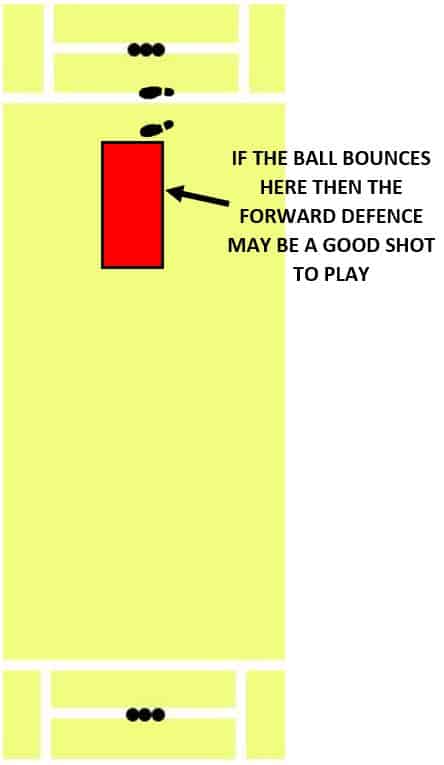
What Areas Of The Field Does The Shot Target?
Given that the forward defence is not an attacking shot, there isn’t really a particular part of the field where a batsman should be looking to hit the ball. Usually when the forward defence is played, the batsman will want to direct the ball directly into the ground, killing the momentum of the delivery and making sure that it can’t be caught by any opportunistic fielders.
However, there are cases where the batsman will make a particularly good contact with the ball when playing this shot, and this usually results in the ball travelling in the areas highlighted below. Although the forward defence is unlikely to cause the ball to rocket off the bat towards the boundary, there is always a chance that a particularly good connection with the ball may give the batsman a chance to steal a single or run a quick two.

How To Play The Forward Defence – The Technical Details
In order to look at the technical details of the forward defence, I think it’s easier to split the shot up into three distinct parts: the foot/leg position, the head position, and the arm/hand position. Let’s look at each one individually…
Foot & Leg Position
As any batsman will know, good footwork is vital when it comes to playing accurate, well-timed cricket shots.
As I mentioned earlier, the forward defence is a front foot shot that is usually played when facing deliveries that bounce as high as the batsman’s knee. This means that the first move a batsman has to make is to push their front foot down the pitch slightly towards where the ball is going to land. How far you move your foot down the pitch usually depends on the speed of the bowler you are facing. Fast bowlers give you less time to move your feet far down the pitch, whereas when facing spinners you will have enough time to get a long stride in.
So, where should your front foot go? Ideally, you should move it down the pitch and make sure it is slightly inside the line of the ball. If you’re not sure what ‘inside the line of the ball’ means, then the diagram below should explain! By moving your front foot inside the line of the ball in this way, you are making sure that you give your bat enough a clear path to come through and strike the ball. If you moved your front foot directly towards the line of the ball, your bat would have to come around your front leg to hit the ball – which is far from ideal!
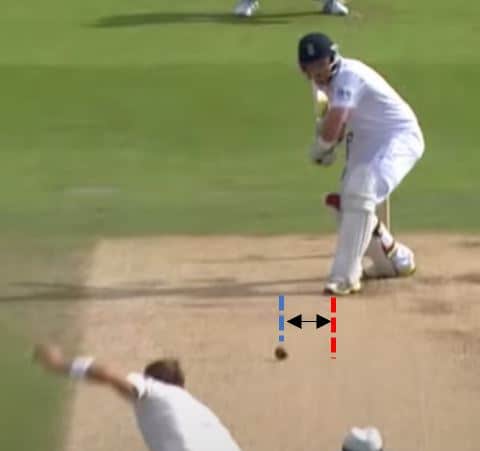
Once you’ve moved your front foot forwards, you should bend your front knee and get your weight over the top of it. If you’ve taken a huge step down the pitch, you’ll need to bend your knee a little more than if you only take a small step! The position of your back leg is less important. If you have taken a long stride down the pitch, your back leg will probably be straight out behind you with the toe of your boot touching the floor. If you have only taken a small step down the pitch, your back leg might be bent a little. As long as you’ve got your front foot/leg in a good position, you should be fine!
Head Position
Your head position is very important no matter what shot you’re playing, but I find that it’s especially important when playing front foot shots like the forward defence!
Basically, when playing the forward defence you should be trying to get your head as close to the line of the ball as possible. If the ball is on an off stump line, then your head should be directly over the top of the ball on an off stump line too. Kevin Pietersen and various other professional batsmen describe this as trying to ‘kiss the ball’ – but all it really means is that you should try to get your head as close to the ball as is reasonably possible (you should never try to literally kiss the ball).
Why is this important? Well, the positioning of your head is key if you want to be well balanced at the crease and while you’re playing your shots. When batting, wherever your head moves, your feet will usually follow. So, getting your head towards the line of the ball is actually a great way of getting your feet in good positions too!

Arm Position & Grip On The Bat
To execute a solid forward defence, you’re going to need to position your bat properly and make good contact with the ball.
As the ball is coming towards you, your bat should swing through with the face of the bat pointing directly towards the ball. As you make contact with the ball, you should aim to keep your front elbow nice and high like is being shown in the photo below! Having your front elbow high like this helps you to keep your bat vertical, which is a critical component of the forward defence. It also enables you to get ‘over the top’ of the ball, which helps you to defend the ball towards the ground rather than causing it to pop up in the air.
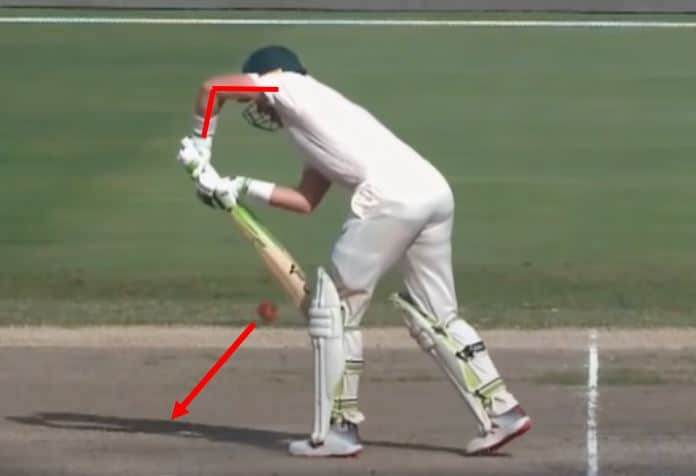
When you make contact with the ball, you should aim to have no visible gap between the line of your bat and your front pad. An example of this is shown in the photo below. If your front pad is on a middle/leg stump line, your bat should be covering the off stump. If your pad is covering the off/middle stump line, then your bat should be slightly to the off side of this, covering the 4th/5th stump line. Getting your bat to cover the line next to your pad helps to protect you from being bowled ‘through the gate’ by any deliveries that seam or swing in towards you unexpectedly. A batsman who plays the forward defence with a large gap between their front pad and their bat is much easier for bowlers to target with deliveries that angle in towards them. You can play with the bat out in front of your pad, as long as it covers the line next to it!
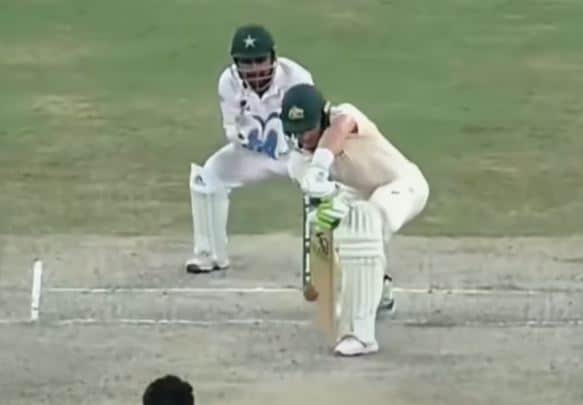
The forward defence is much easier to play properly when you have a loose grip on the bat with your bottom hand. Batsmen who have a very tight bottom hand grip will struggle to keep the bat vertical when playing the shot and will often bring the bat through at awkward angles. This puts them at greater risk of missing the ball and getting out bowled or LBW. This isn’t to say it’s impossible for batsmen with strong bottom hand grips to play a forward defence, but trust me, a loose bottom hand makes it a lot simpler! Think of your top hand as the guiding hand, whilst the bottom hand is just there to provide a bit of stability.
Other Tips & Drills That Will Help With Playing The Forward Defence
In this section I’ll share some other things that will help you improve your ability to play solid forward defence shots. Let’s get started!
Practice The Shot Against A Bowling Machine Or Throw Downs
By far the best way to get a feel for a cricket shot is by rehearsing it for many hours during your net sessions. I feel like the perfect way to do this (especially when you’re new to a shot), is to get a coach or a partner to give you plenty of throw downs that will allow you to practice it. If you’re lucky enough to have access to a bowling machine, you could also use that!
If you’re practicing the shot for the first time, get your coach or a partner to throw you a few balls underarm that bounce a few feet in front of you. These slow throws will allow you to become comfortable with the movements required to play the forward defence, and once you’ve achieved that you can begin to increase the speed of the delivery. To increase the speed and the difficulty level, get your partner to throw balls overarm at you. You could also purchase a ‘sidearm thrower’ (linked here), which many professional batsmen use during their practice sessions. Sidearm throwers allow your coaches or partners to test you with quick, bouncing deliveries that mimic the ones you would receive from an actual fast bowler! They’re a great bit of kit and I’d advise all players to purchase one.
To practice a shot like the forward defence properly, I’d recommend devoting a decent amount of your practice sessions to it. Ask your coaches or your partner to throw 50 balls at you so you can attempt the shot 50 times, and then do the same thing in your next few net sessions. This kind of commitment to practicing a shot really allows you to get into the groove of playing it and helps to ingrain it into your muscle memory. Ideally, you want the shot to feel completely natural to you and playing it repeatedly in this way is the method for achieving that.
Play The Ball Late & Under Your Eyes
When batting against skilled bowlers in tough conditions, one of the best things you can do is try to play the ball late once it is underneath your eyes. If you watch batsmen like Kane Williamson and Joe Root bat, you’ll see that they almost always play the ball late, waiting for it to come to them rather than lunging forwards towards it. This is just one of the reasons why they’re both so successful!
Playing the ball late helps when playing the forward defence because it gives you the maximum amount of time to watch how the ball is moving in the air. Giving yourself a bit of extra time like this can make a huge difference, especially when facing elite bowling! Additionally, playing the ball late means that you’re more likely to play the ball with soft hands and defend the ball into the ground, rather than lunging forwards, hitting the ball with hard hands and potentially offering a catch to a close fielder!
To teach yourself to play the ball late, think about letting the ball hit your bat rather than thrusting your bat forwards to strike the ball. If you’re a naturally aggressive player who likes to come forward and attack then this will require a slight change in mentality, but with plenty of work in the nets you’ll be able to get it right. I’d recommend working closely with a coach or a parent and getting them to watch whether you’re playing the ball late enough.
Use Drills That Will Help You To Play The Shot
Over my years watching and playing the sport I’ve picked up a few excellent drills that professional batsmen use to teach themselves to play the ball late and defend the ball into the ground. One of my favourites is a drill that is specific useful for practicing the forward defence. To use the drill, follow these steps:
- The first thing you need in order to perform this drill is a set of hoops or something similar that you can lay out on the ground in front of you when you’re batting. You can find a set of hoops linked on amazon here, but if you can’t get your hands on those, you could use other things like items of clothing etc.
- When you have the hoops or the items that you will use, lay them out on the ground about a stride length away from you. I’ve included a diagram showing how you could arrange them that you can see below.
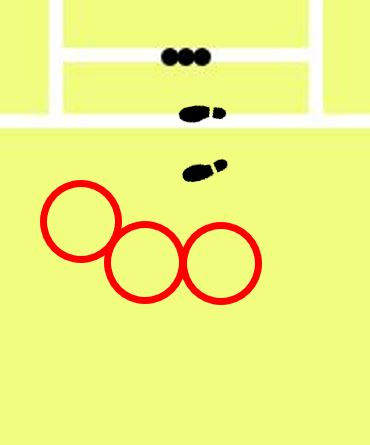
- Find yourself a partner or a coach or someone to throw the ball to you, and then get into position at the crease, ready to receive the ball.
- Once you’re in position, ask your partner to throw the ball towards you at whatever speed you’re comfortable with. Your task is to play the forward defence to each delivery and try to direct the ball into the hoops.
- If you’re using this drill in the nets and you don’t have any hoops or anything else to place on the ground, simply copy steps 3 & 4 above but try to avoid letting the ball touch the sides of the net once you have hit it. If you defend the ball well and kill the momentum enough, the ball will be much less likely to touch the sides of the net.
The drill above is great because it teaches you how to hit the ball into the ground and kill the momentum of the ball when playing the forward defence. When you’re batting in an actual game, some opposition captains will place fielders close to the bat in the hope that you mistime your forward defence and pop the ball up in the air towards them. Therefore, ensuring that you hit the ball towards the ground more often than not is a skill that you should definitely be trying to develop!
Conclusion
As I laid out at the start of the post, the forward defence is a shot that you’re going to need to master if you want to be a successful batsman in any form of cricket. In my view, a good defensive game is the foundation which an expansive attacking game should be built on top of! I hope this post has given you the information you need to master the shot.
If you liked this post, I’d recommend checking out one of my other similar ones which looks at how to play the cover drive. Click here if you’re interested!
